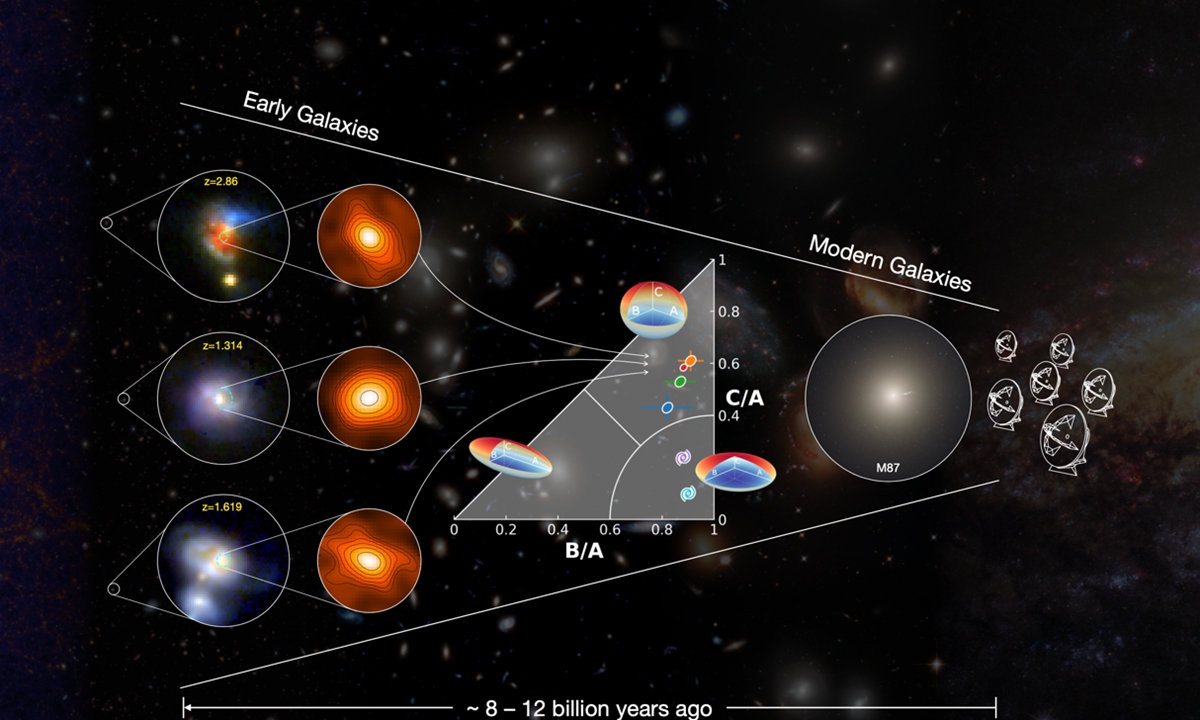
Schematic diagram illustrating the process of spheroid formation in distant submillimetre-bright galaxies and the possible link with the evolution of giant elliptical galaxies in the present-day Universe Photo: Courtesy of Purple Mountain Observatory (PMO), Chinese Academy of Sciences (CAS)
Astronomers from China, France and Japan discovered in situ spheroid formation in distant starburst galaxies. The study provides the first solid observational evidence that spheroids can form directly through intense star formation within the cores of highly luminous starburst galaxies in the early universe, based on a new perspective from the submillimeter band, the Global Times learned from the Purple Mountain Observatory (PMO), Chinese Academy of Sciences (CAS), on Thursday.
The discovery was published on Thursday in the Nature journal. It is believed to significantly impact models of galaxy evolution and deepen scientists' understanding of how galaxies form and evolve across the universe, according to the PMO.
Galaxies in today's universe are diverse in morphologies and can be roughly divided into two categories: younger, disk-like spiral galaxies, like the Milky Way, that are still forming new stars; and older, elliptical galaxies, which are dominated by a central bulge, no longer forming stars and mostly lacking gas. These spheroidal galaxies are home to very old stars, yet how they formed has remained a mystery until now.
In the study, researchers from PMO, French Alternative Energies and Atomic Energy Commission (CEA) Paris-Saclay and Kavil Institute for the Physics and Mathematics of the Universe, The University of Tokyo, analyzed data from the Atacama Large Millimeter/submillimeter Array (ALMA) on over 100 Submillimeter Bright Galaxies (SMGs) with redshifts dating to the "Cosmic noon" era, when the universe was between around 8-12 billion years ago and many galaxies were actively forming stars.
Researchers used statistical analysis of the surface brightness distribution of dust emission in the submillimeter band, combined with a novel analysis technique.
They found that the submillimeter emission in most of sample galaxies are very compact, with surface brightness profiles deviate significantly from those of exponential disks. This suggests that the submillimeter emission typically comes from structures that are already spheroid-like.
Further evidence supporting the spheroidal shape theory comes from a detailed analysis of galaxies' 3D geometry. Modeling based on the skewed-high axis-ratio distribution shows that the ratio of the shortest to the longest of their three axes is, on average, half and increases with spatial compactness. This indicates that most of these highly star-forming galaxies are intrinsically spherical rather than disk-shaped.
Supported by various numerical simulations, this discovery has shown that the main mechanism behind the formation of these spheroids is the simultaneous action of cold gas accretion and galaxy interactions. This process is thought to have been quite common in the early universe, during the period when most spheroids were forming. It could redefine how human understands galaxy formation.




